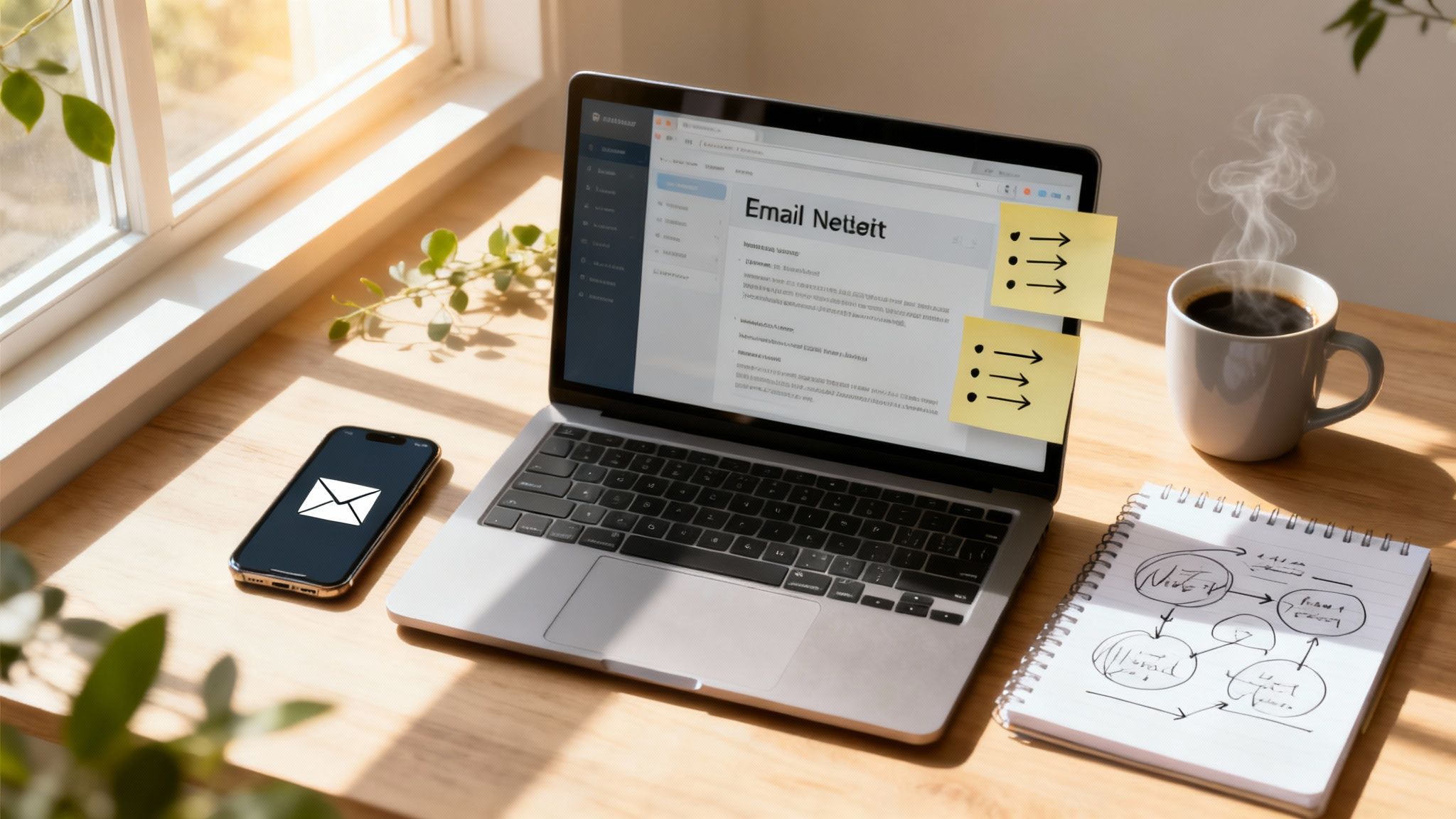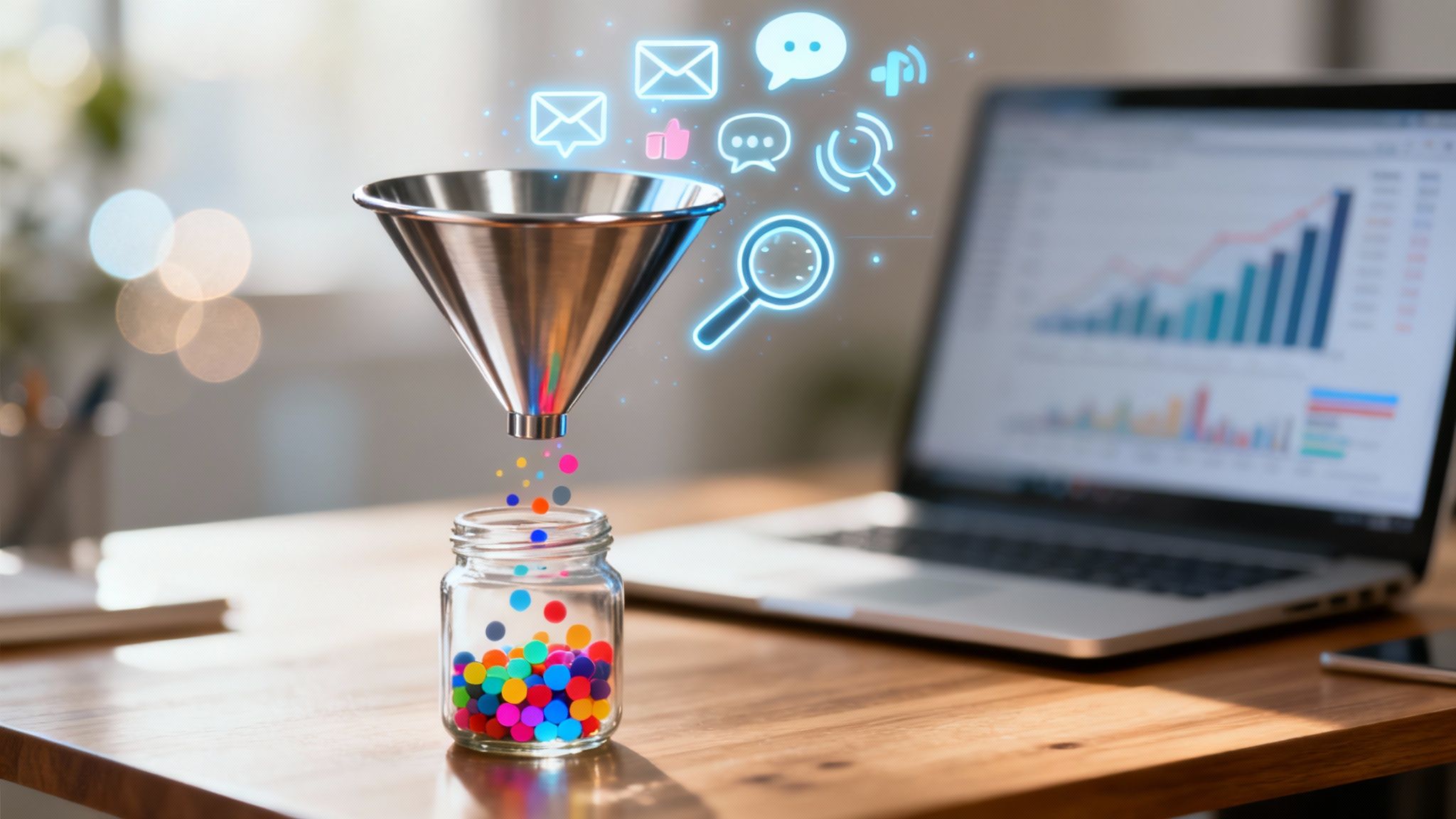
Tired of constantly chasing down new leads? It’s a familiar story for most marketers and creators: the endless pressure to fill the sales pipeline, often leading to costly ad campaigns and cold outreach that today's savvy buyers simply tune out. This hamster wheel of 'push' marketing feels exhausting because it's built on interruptions, not connections. But what if you could attract genuinely interested prospects instead of shouting for attention? That’s exactly what inbound marketing lead generation is designed to do, creating a sustainable engine that pulls in qualified leads by offering real value.
What is Inbound Marketing Lead Generation?
At its heart, inbound marketing is about building relationships, not just broadcasting a message. Instead of interrupting people with ads, you create valuable content and experiences that pull your ideal customers toward you. This approach focuses on solving problems and earning trust from the very first click. It’s a strategic shift from a salesy monologue to a helpful dialogue. When done right, you build a predictable growth engine fueled by prospects who are genuinely interested in what you have to offer, making the entire sales process smoother and more effective.
- Create Value First: Pull in your ideal customers by creating insightful content that answers the questions they’re already asking. For a deep dive, check out our essential SEO copywriting tips.
- Build Trust Over Time: Nurture those early connections with helpful, relevant communication that doesn't feel pushy.
- Solve, Don't Sell: Position your brand as the go-to expert and helpful resource, not just another vendor trying to make a sale.
The Four Stages of the Inbound Journey
Great inbound marketing lead generation isn't a one-off trick; it's a strategic journey. Think of it less like a rigid funnel and more like a flywheel that guides a stranger from "who are you?" to becoming a loyal advocate. This process unfolds across four key stages, each with its own goals and tactics designed to build momentum and trust one step at a time. When you master this framework, you stop guessing and start building a predictable growth engine where each stage naturally flows into the next.
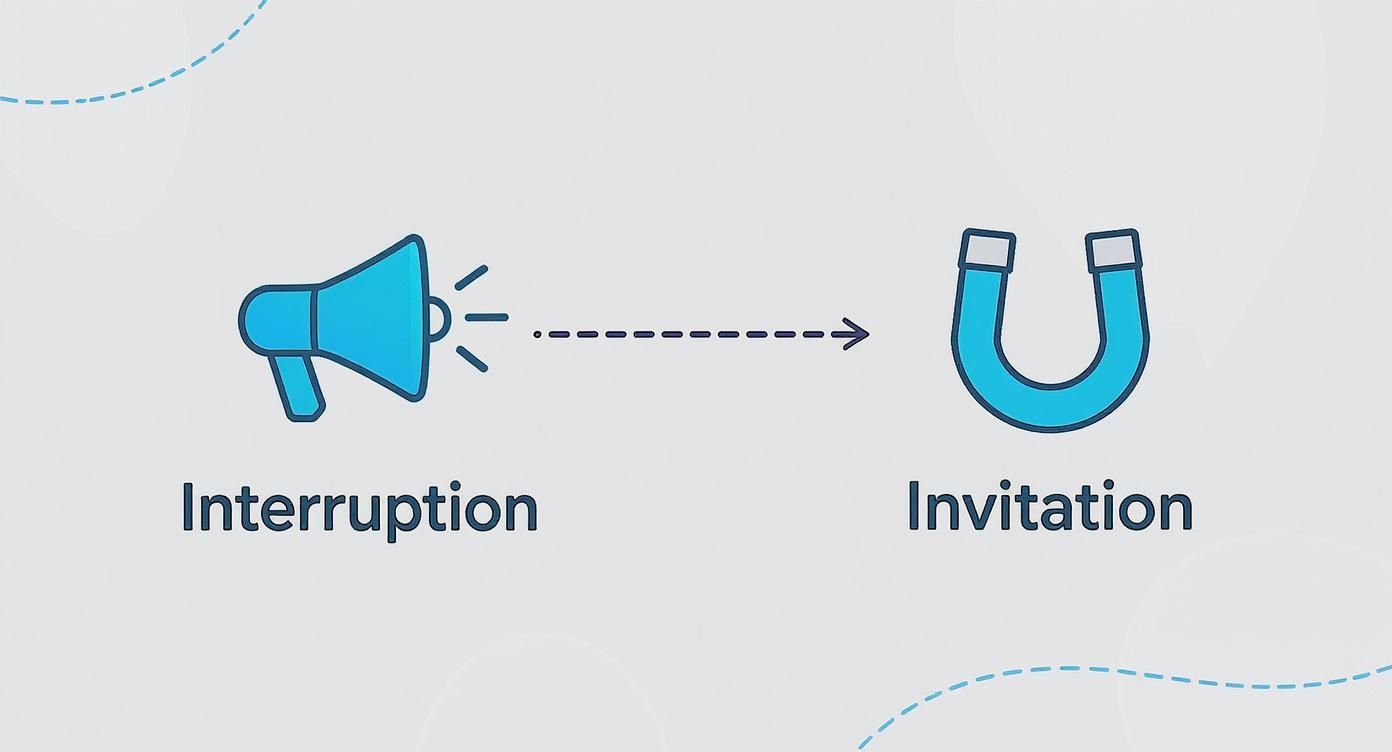
Stage 1: Attract
First, you need to get the right people to your digital front door. This isn't about casting a wide, generic net; it's about using a powerful magnet to pull in your ideal customers—the ones already looking for the solutions you offer. The goal here is to become the resource they find when they're trying to solve a problem. Your main tools for the job are SEO-optimized blog posts, engaging social media content, and valuable video tutorials. By offering real value upfront, you establish yourself as an expert and build trust long before asking for anything in return.
Stage 2: Convert
Okay, you've attracted visitors to your site. Now what? The "Convert" stage is all about turning that anonymous traffic into identifiable leads. Your mission is to get their contact information so you have permission to continue the conversation. You do this by offering a fair trade: a high-value resource, often called a lead magnet, in exchange for their details. Think of a freelance designer offering a "Brand Style Guide Checklist" via a landing page. The visitor gets a useful tool, and the designer gets a warm lead who is clearly interested in branding services. It’s a win-win exchange that opens a direct line of communication.
Stage 3: Close
A list of leads is promising, but it doesn't pay the bills. The "Close" stage is all about turning interested leads into paying customers. This is where you nurture the relationship, guiding them from consideration to decision. This is also where tools like marketing automation and a solid CRM (Customer Relationship Management) system become your best friends. A well-planned inbound strategy is ten times more effective for lead conversion than outbound methods. By sending the right message at the right time—like a targeted case study or a special demo offer—you build on the trust you've already established and make the sale feel like a natural next step. For a deeper dive, check out our guides on lead nurturing strategies.
Stage 4: Delight
The journey isn't over when the deal is signed. The final stage, "Delight," is about turning new customers into loyal fans who promote your brand for you. This is the secret to long-term, sustainable growth because happy customers buy again and they bring their friends. This is what we call the inbound flywheel—delighted customers create the momentum that brings new people into your orbit. Delighting customers means going above and beyond with excellent customer support, exclusive content, and community-building initiatives. When you focus on delight, you build a self-powering growth machine where your best marketers are the customers you've already won.
👉 Try MediaWorkbench.ai for free – schedule your posts and generate AI content in one place!
Proven Inbound Tactics to Generate Leads
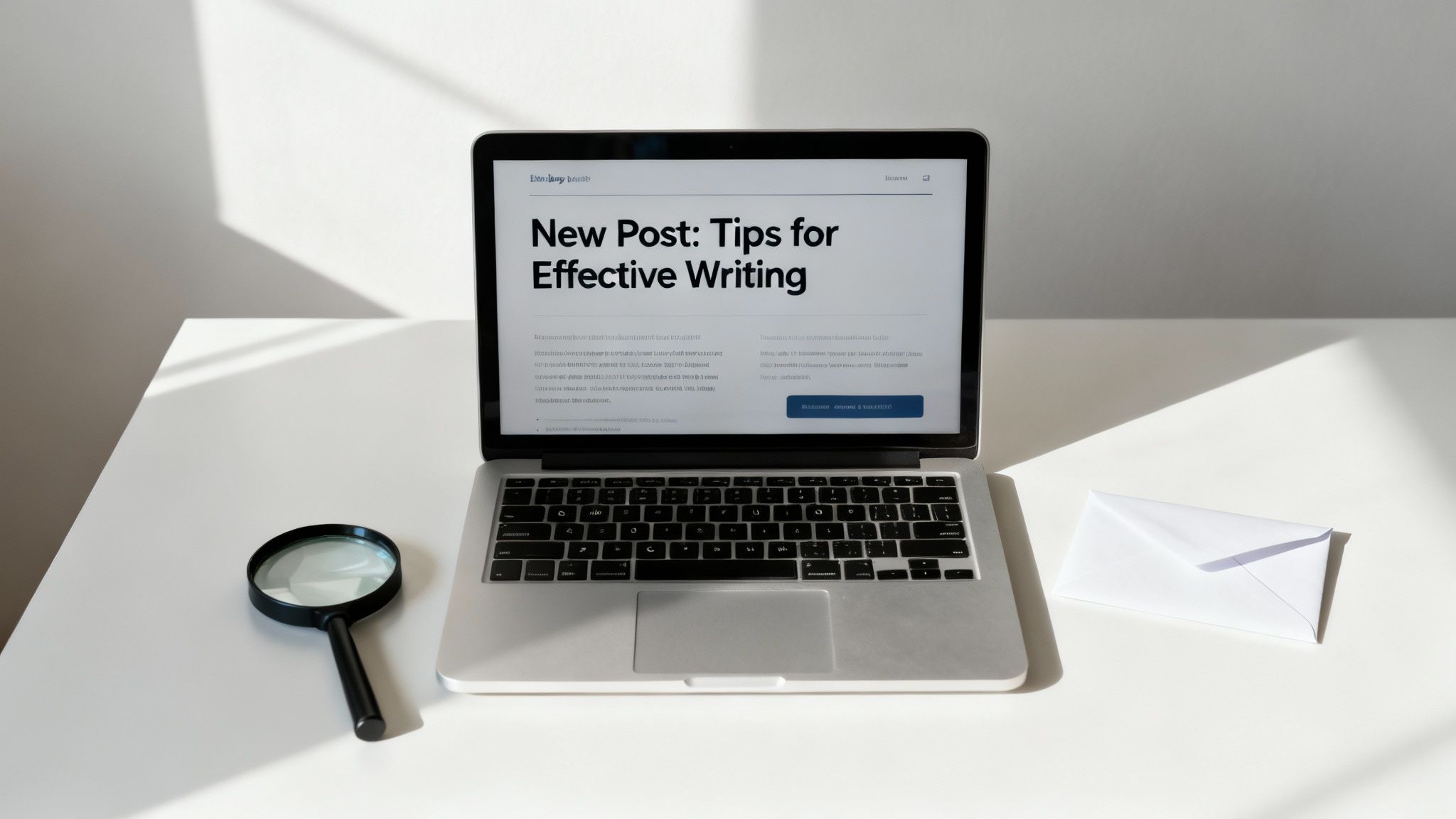
Knowing the inbound framework is one thing, but actually putting it to work requires a smart mix of tactics. Real success in inbound marketing lead generation comes from strategies that attract, engage, and convert the right people. You don’t have to do everything at once. The key is to master a few core tactics that build on each other and deliver consistent results. Think of it like a recipe: your content is the main ingredient, SEO gets it seen, and social media and email are how you serve it up to an eager audience.
Master Content Marketing to Build Authority
At its core, inbound marketing runs on great content. This isn't just about pumping out blog posts; it's about becoming the go-to resource that solves your audience's biggest problems. When you consistently deliver value, you build trust and pull prospects in naturally.
Here are a few of the heaviest hitters in content:
- Insightful Blog Posts: A digital marketing agency could write "10 Google Ads Mistakes Burning Your Budget" to attract businesses struggling with ad spend.
- In-Depth eBooks and Whitepapers: A SaaS company might offer an eBook on "The Ultimate Guide to Automating Your Workflow" in exchange for an email, capturing a lead actively looking for a fix.
- Compelling Case Studies: Showing exactly how you helped a real client get results is a powerful way to win over prospects on the fence.
For those targeting other businesses, a deep dive into B2B lead generation strategies can provide focused insights.
Fuel Discovery with Search Engine Optimization
Awesome content is useless if no one sees it. That’s where Search Engine Optimization (SEO) comes in. SEO is the science of getting your website to show up when people search for answers on Google. It ensures that when your ideal customer types a problem into the search bar, your website is one of the first things they see. For instance, a freelance copywriter could optimize a post for "how to write landing page copy that converts." When a startup founder searches that phrase, the copywriter's article pops up, attracting a super-relevant lead. A strong SEO strategy turns your website into a 24/7 inbound marketing lead generation machine.
Engage and Nurture Through Social Media
Social media is where your brand’s personality comes to life. It’s more than a place to post links; it’s a platform for conversation and community. LinkedIn, for example, is a goldmine for B2B marketers and agencies. Sharing expert insights and joining industry discussions can attract high-value leads. A content creator could use Instagram Reels to share quick video editing tips, driving followers to a full tutorial on their blog. This approach expands your reach and gives potential leads more opportunities to engage with your brand in a low-pressure environment.
Scale Relationships with Email Marketing
Once you've captured an email, the real relationship building begins. Email marketing is your direct line to leads, allowing you to deliver value over time and guide them toward a purchase. Effective email is all about personalization. A simple lead nurturing sequence might look like this:
- Welcome Email: Deliver the lead magnet and offer a quick intro to your brand.
- Value-Add Emails: Send related tips or blog posts over the next few weeks.
- Case Study/Testimonial: Share a success story to build credibility.
- Soft Call-to-Action: Invite them to a webinar or a free tool.
- Direct Offer: For engaged leads, present a clear offer like a free trial.
This value-first approach keeps your brand top-of-mind. To take this to the next level, it's worth exploring how to use AI for marketing to automate and personalize campaigns at scale.
Building Your Inbound Marketing Tech Stack
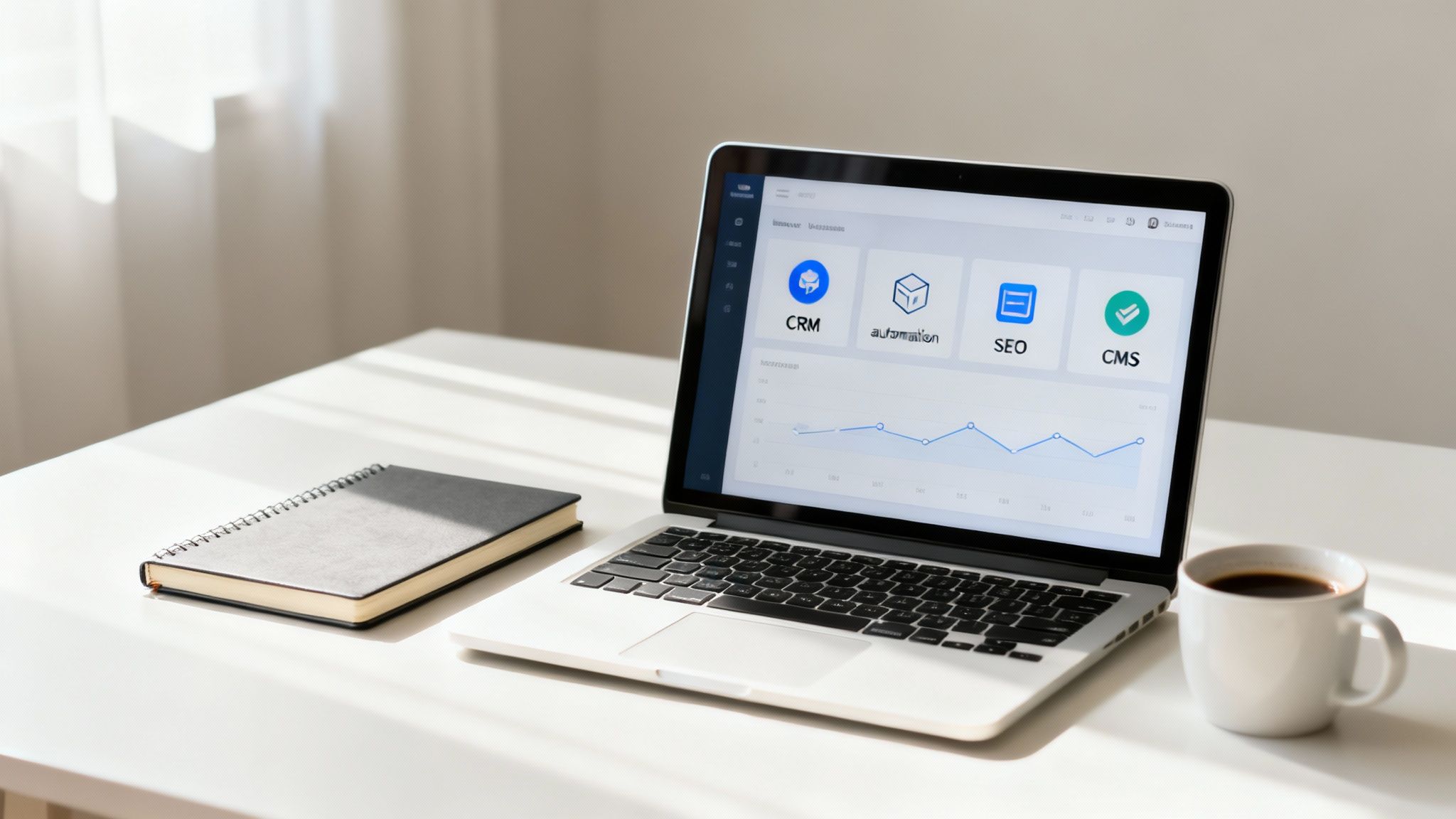
An effective inbound marketing lead generation strategy is powered by a smart set of technology. Your tech stack is the collection of tools that automates grunt work, collects crucial data, and ties your efforts into a cohesive machine. Without the right tools, great content can fall flat and potential leads can slip through the cracks. It's about strategically picking platforms that solve real problems at each stage of the inbound journey, from attracting strangers to delighting loyal customers.
Customer Relationship Management (CRM)
The heart of any inbound tech stack is your Customer Relationship Management (CRM) platform. A CRM acts as the single source of truth for every interaction a lead has with your brand. Platforms like HubSpot or Salesforce provide a 360-degree view of the customer journey. For a marketing agency, this means seeing which blog post a lead first read, what eBook they downloaded, and when they booked a consultation. This unified view is essential for personalizing outreach and ensuring a seamless handoff from marketing to sales.
Marketing Automation
While a CRM holds the data, Marketing Automation software puts it to work. These tools are the engines that drive your lead nurturing, letting you build sophisticated workflows that deliver the right message at the right time. Tools like Marketo or ActiveCampaign let you create email sequences that trigger based on user actions. For example, if someone downloads a case study on social media services, your platform can automatically start a series of follow-up emails with more social media tips. Mastering these systems is a game-changer; get a head start by exploring marketing automation best practices.
SEO Tools
You can't attract an audience if they can't find you on Google. SEO tools are your eyes and ears in the search world, helping you figure out what your audience is looking for and how you can rank for those terms. Platforms like Ahrefs and Semrush are critical for the "Attract" stage, offering features for keyword research, competitor analysis, backlink monitoring, and technical site audits. This data-driven approach removes the guesswork from creating content that gets discovered.
Content Management System (CMS)
Finally, all that amazing content needs a home. A Content Management System (CMS) is the platform you use to build your website, publish your blog, and create landing pages. WordPress is the world’s most popular CMS for a reason—it’s incredibly flexible and user-friendly. A well-built CMS makes it simple for your team to create and update content without needing a developer for every small change. This agility is non-negotiable for a successful content program, allowing you to quickly publish articles, spin up landing pages, and optimize your site for conversions.
Measuring Your Inbound Marketing Success
Great inbound marketing is a science. If you can’t measure what’s working, you’re flying blind—burning time and money with no real sense of the return. Knowing your numbers helps you prove ROI and constantly sharpen your strategy. When you track the right data, you stop guessing and start making informed decisions. It gives you the hard proof needed to justify your budget, pivot when necessary, and show leadership how your marketing efforts are fueling the bottom line.
Top-of-Funnel Metrics: Reaching the Right People
At the top of the funnel (ToFu), your mission is to attract the right audience. These metrics tell you how well your brand is getting noticed by potential customers. Key ToFu metrics to watch include:
- Organic Traffic: How many visitors find you through search engines? A steady increase is a great sign your SEO strategy is working.
- Keyword Rankings: Where do you show up in search results for your most important keywords? Better rankings translate to more visibility.
- Social Media Reach: How many people are seeing your content on social platforms? It’s a solid indicator of brand awareness.
Middle-of-Funnel Metrics: Converting Visitors
Once you have visitors, the challenge is turning them into leads. Middle-of-funnel (MoFu) metrics measure the efficiency of that conversion process. These numbers tell you how well your landing pages and calls-to-action are working. To get this right, you have to measure content marketing ROI. Important MoFu metrics include:
- Lead Conversion Rate: What percentage of visitors become a lead by filling out a form? If 100 people visit a page and 5 fill out the form, your conversion rate is 5%.
- Cost Per Lead (CPL): How much are you spending to get one lead? A lower CPL means your campaigns are more efficient. Inbound leads are 61% less expensive than outbound leads, highlighting the cost-effectiveness of this approach.
Bottom-of-Funnel Metrics: Driving Business Impact
Ultimately, marketing's job is to drive revenue. Bottom-of-funnel (BoFu) metrics connect your lead generation efforts directly to sales and business growth. These are the numbers your CEO cares about most. The most important BoFu metrics are:
- Customer Acquisition Cost (CAC): What is the total sales and marketing cost to acquire one new customer?
- Customer Lifetime Value (LTV): How much total revenue can you expect from a single customer over your entire relationship?
- LTV to CAC Ratio: This compares a customer's lifetime value to the cost of acquiring them. A healthy ratio (typically 3:1 or better) is the ultimate proof of a sustainable business model.
Conclusion: Start Building Your Inbound Engine
We’ve covered the entire journey, from attracting strangers with valuable content to delighting customers and turning them into promoters. Successful inbound marketing lead generation is not about quick tricks; it’s about building a reliable system that consistently brings in the right kind of leads for your business. By combining smart tactics with the right technology and keeping a close eye on your data, marketing transforms from an expense into a predictable engine for revenue. The path is clear—now it's your turn to get that engine running. Start by identifying one area for improvement and build momentum from there.
Ready to power up your content creation for your inbound strategy? Media Workbench AI provides hundreds of templates and AI-powered tools to help you generate blog posts, social media content, and marketing copy in minutes. Start creating faster and smarter with Media Workbench AI today.

